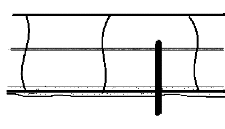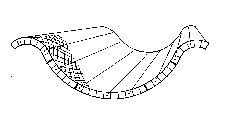| Features |
Hyson Cells with concrete
Importance of the integral rigging
Lends rigidity for filling
To enable the cell wall distortion which is so important for the mechanical interlock, the cells are fabricated from High Density Polyethlene (HDPE) film. The HDPE is also suitable for use with the concrete because it is impermeable with a smooth surface and does not stick to the concrete fill. This HDPE film is, however, lightweight and is not rigid.
There is a danger that the cells may collapse under filling and they must therefore be supported. (For the same reason special attention must be paid to the concrete mix proportions). The laced rigging is supplied ex factory. The rigging pulls the cells very taut and lends temporary rigidity for the filling operation.
 Pegged rigging supports the cells
Pegged rigging supports the cellsNote that if rigging is not used and the cells should collapse it is a situation that cannot be rectified. That section of the works must be cleared of the concrete debris and laid from scratch using new cells - a very costly excercise!
 Irretrievable collapse
Irretrievable collapse
Prevents pooling beneath the cell slab
If the cells are not securely fixed to the underlying material then the lightweight cell mat will tend to "float" on the poured concrete. A continuous slab of concrete will pool beneath the cell mat. The cell matrix now ceases to perform its function of dividing the slab into discrete interlocking blocks. Curing shrinkage no longer results in controlled cracks of only a few microns. Instead, the slab formed from the pooled concrete will result in uncontrolled cracking at its weakest point.
 Pooling beneath the blocks
Pooling beneath the blocks
These cracks may be millimetres wide. They will also probably propagate through the slab to the surface. Fines may now be allowed to pump from the underlying material and surface water will penentrate to destroy the underlying layerworks
The rigging is used to cause the cells to bear tightly against the underlying material. A thin bedding layer of sand is also recommended to assist seal off the bottom of the cells
Note that there is a similar consequence from Overfilling, discussed under Design and Practical
Prevent bridging concave surfaces
Anchoring to the underlying material is particularly important with concave surfaces such as with a drain liner. The rigging strings which run along the direction of the drain are attached to anchoring pegs to draw the "flat" mat down into the concave shape.
 Longitudanal rigging assists pegging into concave profile
Longitudanal rigging assists pegging into concave profile
Termination into cut-off
If not butting to a kerb the Hyson Cells mat must terminate in a "tuck-in" terminating cut-off beam to prevent edge damage. While this may be done using pegs alone, the rigging makes the job quicker and easier.
Armouring an impermeable liner
This is a special case. When placing a concrete cell slab over an impermeable liner it is not possible to use anchoring pegs in the body of the mat because the liner may not be punctured. However it is still possible to draw the cells sufficiently taut and hold it fairly tightly down for filling by use of the rigging. This case is discussed in detail on the toxic ponds / landfill page
|
Contact us at info@hysoncells.co.za |